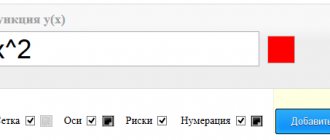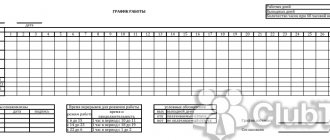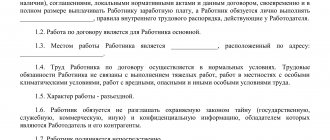Definition
According to Article 102 of the Labor Code of the Russian Federation, a flexible work schedule is an agreement between the employer and the worker on the beginning and end of the working day. At the same time, the law states that the employer and employee can vary working hours by mutual desire and agreement.
We talk in more detail about how the work schedule and hours are reflected in the employment contract here.
Flexible schedule is divided into several types:
- Work in shifts . The schedule is widely known to every person. This is how police officers, medical personnel, etc. work.
- Free mode . This option is suitable for artists, journalists and writers. Creative activity is difficult to measure in a standard way.
- Sliding mode . In this schedule, working hours are standard. A person works as much as his colleagues work. The only difference is that the opening hours are “floating”. For example, an employee may come to work not at 10:00, but at 8:00, and, accordingly, leave two hours earlier.
Irregular working hours are regulated by Article 101 of the Labor Code of the Russian Federation.
How is flexible working time established?
According to the employment contract, the employee is obliged to follow all the rules established in this agreement. GDV (flexible work schedule) is a form of organizing the duration of the working day, during which the employee independently determines his working day, which must first be agreed with the manager.
The main point in this mode is the implementation of a complete time plan for a set period.
A floating work regime is established without a time limit or for any period agreed with the manager.
If the schedule is established by agreement of the parties, according to the rules of the Labor Code of the Russian Federation, then the employee can make his own choice. During discussions, it is possible to establish the details of the regime and wages according to a flexible schedule.
It is necessary to establish a sliding regime by accepting an application from the employee, in which he agrees to change the working conditions. In this statement, you must indicate the desired time for completing the tasks and the period that will limit the effect of this change.
After confirmation of the change, an internal order is issued, a sample of which can be found on the Internet.
Features of working on a flexible schedule
When working in flexible time mode, the beginning, end or total duration of workdays must be specified by mutual agreement of the participants in the working relationship, in accordance with Article 102 of the Labor Code of the Russian Federation.
Work in this mode does not affect the employee’s remuneration, and also does not affect additional benefits and individual bonuses. Most often, this change occurs by the employee’s decision as individual circumstances arise.
For what positions is it suitable?
An employment contract with a sliding schedule applies to almost all positions. This especially applies to office positions, such as secretary, bank specialist, manager. If such a schedule is convenient for the employer and employee, then a sliding schedule can be organized for absolutely any position. Especially if the employee studies or works part-time.
Shift schedules have always been popular. The presidents of large industries and various factories wanted production not to stop, and the enterprise to function full time. But the desire of the management contradicted the current legislation, since working without days off and lunch is strictly prohibited. In this regard, a system of shift work schedules was developed (read about how such a schedule is displayed in employment contracts here). The flexible schedule system is used in many areas of activity .
A free schedule, as mentioned above, is most suitable for creative people (designers, artists, poets, etc.).
How is sliding time calculated?
For the proper functioning of the company's activities, it is necessary to control and maintain records of working hours.
Let's look at three types of sliding time accounting:
- Daily accounting. In this case, a certain number of hours is established, which in any case must be worked by workers.
- If it is not possible to provide control in one day, a weekly standard of hours is established.
- If it is not possible to control the situation with the two above types, then a monthly form for recording working hours is used.
The employer always organizes working hours and is responsible for this. These responsibilities are the responsibility of HR specialists.
For registration and accounting, the unified form T-13 is used.
Cases when this mode cannot be used
For enterprises with special working conditions, a flexible schedule is not suitable (we talked about what working conditions exist and how they are reflected in the employment contract in a separate article). Especially if the organization has weak labor discipline.
In addition, in the service sector and public services, the introduction of a flexible schedule is also not possible. Small private firms have much more opportunities in this regard.
On our website there are other expert publications that talk about what types of work can be reflected in an employment contract, as well as how to correctly indicate the official salary, hourly or piece-rate payment in the agreement.
About the sliding schedule
Sometimes employers have difficulty distinguishing between concepts such as flexible and sliding hours. However, you should know that these are different things.
A rotating work schedule is when an employee is given days off according to a changing work schedule. Simply put, the weekend falls on a different day each week, not just Saturday and Sunday. For example, if a company operates daily, then employees may be given days off on Tuesday and Wednesday in one week, and on Thursday and Friday in another.
This version of the working schedule as a sliding schedule is determined during employment, that is, it is initially prescribed in the employment contract. To transfer already employed employees to a staggered schedule, an additional agreement to the contract is concluded. Along with it, an Order is issued in free form, which requires familiarization by the employee against signature.
It should be clarified that in this case, the employer will need to draw up a work schedule for a certain period of time in advance (weekly or monthly), and also make sure that all employees are familiar with it, that is, sign their signatures. Even before the start of the work week, subordinates will know when they will work and when to rest. In an agreement or other local act, you can specify a minimum period for familiarizing employees with such a schedule. If this condition is already defined in a local act, then when hiring, it is important to include this clause in the employment contract.
Elements of “floating” working time
These include:
- Lunch break . According to Article 108 of the Labor Code of the Russian Federation, every worker has the right to eat and rest. Lunch time should not be less than 30 minutes.
- Variable time . This is the period of time that the employee can independently choose (determining the beginning and end of the working day).
- Fixed working hours . At this time, the employee must always be at his workplace in the organization.
These elements can be changed and supplemented.
How to apply correctly?
In order to correctly reflect the data in the employment contract, it is necessary to record the phrase “Flexible work schedule” in the paragraph “Conditions and nature of work”. And then supplement this section with the necessary paragraphs and subparagraphs.
Changes to the employment contract are made after agreement by both parties. Such a procedure is not feasible unilaterally.
What could the wording be?
The section wording might look something like this:
- Employee Smirnov I.G. a six-day work week is established. The employee chooses the days independently.
- Employee Mironova O.I. a flexible schedule of 30 hours per week is established.
- The lunch break for employees is from 12:30 to 13:00.
- A monthly type of accounting period is assigned.
Other sections of the employment contract with a flexible schedule do not differ from those with a regular working day. The following information is required :
- rights and obligations of the parties;
- place of work;
- guarantees that a worker is entitled to according to the Labor Code of the Russian Federation;
- terms of vacations;
- details of the employer and the employer.
We provide more details about the conditions and content of employment contracts, as well as what clauses should be displayed in them, in a special material.
How to transfer an employee to a flexible work schedule
Tamara FEDOROVA, lawyer, leading expert of the magazine “Personnel Business”
In the fall, employees usually more often turn to management with a request to establish preferential working conditions for them.
After all, classes in various educational institutions begin in September, and students combining work and study, as well as parents of young schoolchildren, need additional free time. Let's talk about what a flexible work schedule is and under what conditions it can be established. Time to work
In any organization, from a small company to a giant holding company, the work of personnel is organized in accordance with a certain regime, which must be reflected in the internal labor regulations (Article 189 of the Labor Code of the Russian Federation). The regime determines the length of the working week (five-day or six-day), the exact start and end time of the working day, its total duration, the number of breaks for meals and rest. All employees are required to obey the established rules, otherwise the violator faces disciplinary action.
Working in a flexible schedule does not affect the employee’s remuneration, does not affect the provision of benefits and the calculation of length of service
For certain categories of workers, the rules allow for flexible working hours.
Under this regime, the beginning, end or total duration of the working day is determined by agreement of the parties to the employment contract (Article 102 of the Labor Code of the Russian Federation). As a rule, a flexible schedule is established at the request of the employee. I want to have a rotating schedule
Imagine that an employee, as the head of an organization, has approached you with a request to establish a flexible work schedule for her. She explained her request, for example, by the need for periodic visits to the diagnostic center for preventive medical examinations.
The first question that arises is, are you obligated to satisfy your subordinate’s request? In order to answer it, you should first of all refer to the internal labor regulations in force in the organization. If the document states that the employer is obliged
at the employee’s request to establish flexible working hours, nothing can be done, you need to meet this desire halfway.
A sliding work schedule can be set either without a time limit or for any period convenient for the employee.
If the rules say that such a regime is established by agreement
of the parties to the contract or nothing is said about it at all, you have a certain freedom of choice. You can refuse the employee on the grounds that this form of work is inconvenient for the company, or you can meet her halfway and discuss the details of a flexible schedule. Let's say you chose the second option. What's next?
Application is required
First, you need to require a written statement from the employee. You must have proof that she is not against changing one of the essential terms of the employment contract, namely the terms of working hours*. The application must indicate the desired work schedule
and
the period of time
for which it is set.
We quote the law.
A sliding (flexible) work schedule must provide workers with the duration of basic and weekly rest established by law.
In this case, the maximum total working time per day should be no more than 10 hours. Clause 3.1 of the resolution of the USSR State Committee for Labor and Social Affairs and the All-Union Central Council of Trade Unions of June 6, 1984 No. 170/10-101 “On approval of the regulations on the procedure and conditions for the application of a sliding (flexible) work schedule for women with children”
After you sign your subordinate's application, you should submit it to the company's human resources department.
Based on the application, the personnel officer will prepare a draft amendment to the employment contract and a draft order, which will approve the individual work schedule. Let's see how to correctly create such a schedule. Elements of a moving chart
First of all you need to reflect the variable (flexible)
work time. For example, in accordance with the schedule, an employee can start her working day between 8 and 11 o’clock and end between 17 and 20 o’clock.
Then you should decide on a fixed
time. This is the time when the employee must be present at work. Let's say from 11 to 17 o'clock. Fixed working hours are the main part of the working day, which allows you to ensure the normal execution of work and maintain the necessary business contacts.
When developing a rotating schedule, you should not forget about breaks for meals and rest.
, which typically divide a fixed time into two equal parts. Such breaks must be no less than 30 minutes and no more than two hours**.
Control over the timely start and finish of work and the correct use of working time during the working day should be exercised by the head of the structural unit
After the work schedule has been drawn up, you need to decide on the choice of accounting period
. This is the period during which the employee must work the working hours established by law***. This can be either a year, a quarter or a month, or one day****.
For example, if a day is selected as the accounting period, then with a five-day work schedule, working on a schedule of Monday, Wednesday, Friday from 8 to 17, and Tuesday, Thursday from 10 to 19, the employee fully fulfills the terms of your agreement. Since she fully works out her usual norm of 8 hours a day.
If the accounting period is equal to a week, then all the employee’s working days can be of different lengths. The main thing is that over a weekly period she works the established norm, namely 40 hours. You can see what a flexible work schedule will look like in this case on the page above*****.
Sample
Transfer to main mode
After the term of the agreement under which the employee was provided with a sliding schedule has expired, she automatically switches to normal work. You do not need to make any additional instructions in this regard.
If an employee wants to switch to a regular work schedule ahead of schedule, she must proceed in the same manner as when establishing a flexible schedule. Request a corresponding statement, draw up changes to the employment contract, issue an order canceling the flexible work schedule.
However, you must remember that it is your right, not your obligation, to cancel the terms of your flexible working arrangement before the end of the arrangement.
And if for some reason it is not profitable for the organization to meet the employee’s request, you can refuse her this on a completely legal basis. * -The essential terms of an employment contract can only be changed by agreement of the parties. ** -Clause 3.3 of the resolution of the USSR State Committee for Labor and Social Affairs and the All-Union Central Council of Trade Unions dated June 6, 1984 No. 170/10-101 “On approval of the regulations on the procedure and conditions for the application of a sliding (flexible) work schedule for women with children.” The document is published on page 104. *** -Clause 2.1 of the resolution of the USSR State Committee on Labor and Social Issues and the All-Union Central Council of Trade Unions of May 30, 1985 No. 162, No. 12-55 “On approval of recommendations for the use of flexible working time regimes in enterprises in institutions and organizations of sectors of the national economy." The document is published on page 106. **** -The number of hours that an employee needs to work during the accounting period is determined based on the fact that the normal working week is 40 hours (Article 91 of the Labor Code of the Russian Federation). ***** -The same work schedule can be used for a longer accounting period, for example, a month, a quarter, a year. Since it is extremely difficult to schedule every day of work in a long accounting period.






